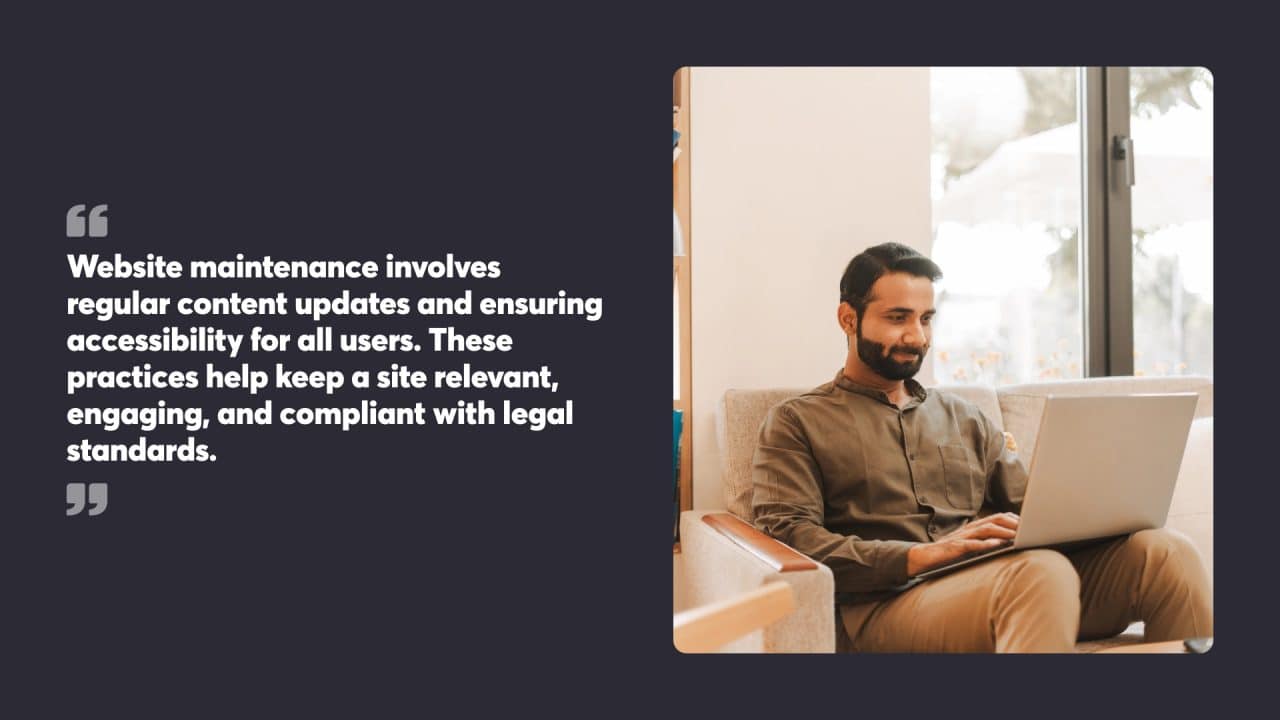
Website maintenance plays a vital role in the success or failure of a business. Regular upkeep of a website involves updating content, monitoring performance, and fixing issues promptly. These activities are crucial for keeping a website functional, secure, and relevant over time.
Proper website maintenance impacts various aspects of an online presence. It supports lead generation, improves visitor engagement, and enhances search engine rankings. Effective search engine optimisation (SEO) is essential for driving traffic to websites and improving rankings on Google. By consistently maintaining a website, businesses can create a highly functional online asset that effectively serves its purpose.
Website maintenance encompasses a range of tasks. These include monitoring web traffic, updating security software, and optimising performance. Monitoring and improving the site’s performance, such as page load speed and security, is crucial as it directly affects how search engines evaluate and rank websites. A well-maintained website provides a better user experience, which can lead to increased conversions and customer retention.
Key Takeaways
- Website maintenance is crucial for ensuring optimal functionality, security, and user experience. It involves tasks such as updating software and plugins and running security scans to keep the website running smoothly and securely.
- Regular website maintenance supports lead generation, improves conversions, and enhances the user experience. By ensuring that the website is up-to-date, fast, and user-friendly, businesses can attract and retain more visitors, ultimately leading to increased revenue.
- A comprehensive website maintenance plan should include backing up the site, checking site speed, performing security updates, reviewing analytics, and testing key features. The frequency of these tasks may vary from monthly to annually based on the website’s specific needs and goals.

Table of Contents
Understanding Website Maintenance
Website maintenance involves regular upkeep to keep a site functioning optimally. It involves various tasks that contribute to a website’s performance, security, and user experience.
Defining Website Maintenance
Website maintenance is the practice of regularly checking, updating, and improving a website to keep it in top shape. It includes tasks like keeping functionality up to date, updating plugins, and applying security patches. The goal is to maintain a website’s functionality, relevance, and safety for visitors.
Website maintenance is an ongoing process. It’s not a one-off task but a continuous effort to keep a site running smoothly. This includes checking for errors and ensuring the site loads quickly.
Regular maintenance helps prevent issues before they become major problems. It also helps keep a website competitive in search engine rankings.
The Role of Regular Website Maintenance
Regular website maintenance plays a key role in a site’s success. It helps keep the site secure by patching vulnerabilities and updating software. This protects both the site and its users from potential cyber threats.
Regular maintenance also improves user experience. It ensures that all features work as intended and that the site loads quickly. This can lead to higher user satisfaction and increased conversions.
From an SEO perspective, regular maintenance is crucial. Search engines favour websites that are regularly updated and free of errors. By maintaining a site regularly, businesses can improve their chances of ranking well in search results.
Components of a Maintenance Plan
A comprehensive website maintenance plan includes several key components. A website maintenance package can protect businesses from losses due to downtime, cyber threats, and poor user experience, while offering cost-effective and tailored solutions.
Technical updates are the most crucial component. This includes updating software, plugins, and themes to their latest versions. It also involves checking and fixing any error messages.
Security is a critical part of any maintenance plan. This includes regular backups, security scans, and updates to security measures. Performance monitoring is also important, checking load times and optimising where needed.
Finally, a good maintenance plan includes regular reviews of the site’s analytics. This helps identify areas for improvement and guides future updates.

Search Engine Optimisation and Maintenance
Search engine optimisation (SEO) plays a crucial role in website maintenance. It affects visibility in search results and drives organic traffic to a site.
Impact on Search Engine Rankings
SEO maintenance directly influences a website’s position in search engine results pages. Regular updates to content, metadata, and site structure signal to search engines that a site is active and relevant. This can lead to improved rankings for targeted keywords.
Fresh, high-quality content helps attract and retain visitors. It also encourages search engines to crawl and index a site more frequently. Broken links, outdated information, and poor user experience can harm rankings. Fixing these issues through ongoing maintenance is vital for SEO success.
Monitoring and analysing website traffic and user behaviour is essential to gain insights into a website’s performance, ensuring timely maintenance to prevent issues that can negatively impact user experience and search rankings.
SEO Strategy and Regular Updates
An effective SEO strategy requires consistent effort and adaptation. Search algorithms change often, making it essential to stay current with best practices. Regular website audits help identify areas for improvement and opportunities to boost rankings.
Keyword research should be an ongoing process. It allows businesses to target new search terms and adapt to changing user behaviour. Updating meta titles, descriptions, and header tags with relevant keywords can improve click-through rates from search results.
Technical SEO elements like site speed, mobile-friendliness, and secure connections (HTTPS) need regular checks and optimisation. These factors impact both user experience and search rankings. Maintaining a strong SEO strategy through ongoing website maintenance is key to long-term online success.
Performance and User Experience
Website performance directly impacts user satisfaction and engagement. Fast-loading pages and smooth functionality create a positive experience for visitors, encouraging them to stay longer and explore more content.
Enhancing Website Speed
Optimising website speed is crucial for retaining visitors and improving search engine rankings. Page load times significantly affect user behaviour, with even small delays causing potential customers to leave. To boost site speed, compress images, minify CSS and JavaScript files, and use caching techniques. Implementing a content delivery network (CDN) can also help distribute content across multiple servers, reducing load times for users in different geographic locations.
Improving Website Uptime
Website uptime refers to the amount of time a site is accessible and functioning properly. Downtime can lead to lost sales, damaged reputation, and decreased search engine rankings. Regular server maintenance, monitoring, and selecting a reliable hosting provider are key to maximising uptime. Implementing redundancy measures, such as backup servers and load balancing, can help mitigate the impact of hardware failures or traffic spikes.
User Experience and Performance Metrics
Tracking performance metrics is essential for identifying areas of improvement and maintaining a high-quality user experience. Key metrics include page load time, time to first byte (TTFB), and bounce rate. Tools like Google Analytics and PageSpeed Insights provide valuable data on site performance and user behaviour. Regularly analysing these metrics allows website owners to make data-driven decisions and prioritise improvements that have the greatest impact on user satisfaction and conversion rates.

Content Management and Accessibility
Website maintenance involves regular content updates and ensuring accessibility for all users. These practices help keep a site relevant, engaging, and compliant with legal standards.
Updating Website Content
Keeping website content fresh is vital for attracting and retaining visitors. A content management system (CMS) simplifies this process, allowing non-technical staff to make changes. Regular updates can include:
- News articles
- Blog posts
- Product information
- Company announcements
Outdated content can harm a site’s credibility and search engine rankings. By consistently refreshing information, businesses can maintain user interest and improve their online presence.
Managing a Content Marketing Strategy
A well-planned content marketing strategy drives traffic and builds brand authority. Key elements include:
- Setting clear goals
- Identifying target audiences
- Creating a content calendar
- Producing high-quality, relevant material
Regularly analysing performance metrics helps refine the strategy. This might involve tracking page views, engagement rates, and conversion data.
Content should align with business objectives while addressing user needs. A mix of formats, such as articles, videos, and infographics, can cater to different preferences.
Ensuring Website Accessibility
Website accessibility makes content available to all users, including those with disabilities. Key practices include:
- Using clear, descriptive headings
- Providing alternative text for images
- Ensuring keyboard navigation
- Maintaining sufficient colour contrast
Accessible websites often perform better in search rankings and reach a wider audience. They also help businesses comply with legal requirements, reducing the risk of discrimination claims.
Regular accessibility audits can identify areas for improvement. Tools like screen readers and keyboard-only navigation tests help simulate different user experiences.

Security and Protection
Website security is crucial for safeguarding sensitive data and maintaining user trust. Regular maintenance helps protect against threats and keeps sites running smoothly.
Addressing Security Vulnerabilities
Security vulnerabilities can expose websites to attacks. Common weaknesses include outdated software, weak passwords, and unpatched systems. Regular scans can spot these issues before hackers do.
Website owners should check for vulnerabilities often. This involves testing all components, including plugins, themes, and core software. Fixing weak spots promptly is key to keeping sites safe.
Third-party security tools can help find and fix problems. These scan websites automatically and alert owners to risks. Some tools even patch vulnerabilities without manual input.
Preventing Cyber Attacks
Cyber attacks can cripple websites and compromise user data. Common threats include malware, DDoS attacks, and SQL injections. Good security practices help ward off these dangers.
Strong passwords and two-factor authentication boost login security. Firewalls block suspicious traffic before it reaches the site. Regular backups allow quick recovery if an attack succeeds.
Educating staff about security risks is vital. Many breaches stem from human error. Teaching proper handling of sensitive data and recognising phishing attempts can prevent incidents.
Security Updates and Disaster Recovery
Security updates patch known vulnerabilities in website software. Applying these promptly is critical for maintaining a secure site. Many attacks target outdated systems with known weaknesses.
Automated update systems can keep sites current with minimal effort. However, testing updates before applying them to live sites is wise. This prevents compatibility issues that could break site functionality.
Disaster recovery plans are essential for bouncing back from successful attacks. These outline steps to restore normal operations quickly. Regular backups, stored securely off-site, form the backbone of most recovery strategies.
Testing recovery plans regularly confirms their effectiveness. This might involve simulating various attack scenarios and practising the response. Such drills help spot weak points in the recovery process.

Maintaining an Online Business Presence
Regular website maintenance is crucial for sustaining a strong online business presence. It helps keep a company’s digital storefront attractive, functional, and engaging for visitors.
Website as a Business’s Online Face
A well-maintained website serves as the digital face of a business. It reflects the company’s professionalism and attention to detail. Regular updates to content, design, and functionality keep the site fresh and relevant. This can include refreshing product information, updating blog posts, and fixing broken links or images. A current and polished website builds trust with visitors and showcases the business’s expertise.
Professional website maintenance services can help businesses stay on top of these tasks. They handle technical aspects like security updates, performance optimisation, and backups. This allows business owners to focus on their core operations while maintaining a top-notch online presence.
Engaging with Potential Customers
A well-maintained website is a powerful tool for engaging potential customers. It provides a platform for businesses to showcase their products or services, share valuable information, and interact with visitors. Regular updates to the site’s content can improve search engine rankings, making it easier for potential customers to find the business online.
Website maintenance also involves monitoring and improving user experience. This includes optimising page load times, ensuring mobile responsiveness, and streamlining navigation. A smooth, user-friendly website keeps visitors engaged and increases the likelihood of converting them into customers.
Regularly updating contact forms, chat functions, and other interactive elements helps businesses stay connected with their audience. This ongoing engagement can lead to increased customer loyalty and word-of-mouth referrals, further strengthening the business’s online presence.

Costs of Website Maintenance
Website maintenance costs vary based on factors like site complexity, required services, and management approach. Regular upkeep is crucial for keeping a website functional and secure.
Understanding Maintenance Costs
At Chillybin, our Website Maintenance Support starts at $147 per month for basic services. Larger, more complex sites may require more extensive maintenance, which we offer for $297 or $497 a month, depending on your needs.
Other common expenses include domain name renewal, hosting fees, and security measures.
Domain names typically cost $10 to $50 per year. Hosting fees vary widely, from $5 to $100+ monthly, depending on the provider and plan. Security features like SSL certificates ($8 to $60 annually) and web application firewalls ($10 to $100 monthly) add to the total.
Content updates, bug fixes, and performance optimisation also contribute to maintenance costs. These services may be charged hourly or included in a package deal.
Budgeting for Ongoing Maintenance
When planning for website maintenance, it’s wise to allocate funds for both expected and unexpected costs. A basic maintenance package might cover routine updates, backups, and security monitoring.
For small to medium-sized websites, budgeting $500 to $1,000 per year is often adequate. Larger sites or those with e-commerce functionality may need to set aside $5,000 or more annually for adding functionality.
It’s important to consider the potential cost of not maintaining a website. Neglecting updates can lead to security vulnerabilities, poor performance, and lost business opportunities. Investing in regular maintenance helps avoid these risks and keeps the site running smoothly.
Website Maintenance Services and Packages
Website maintenance services and packages offer ongoing support to keep websites functioning smoothly. These solutions range from basic upkeep to comprehensive care, addressing various aspects of website health and performance.
Choosing the Right Service
Professional website maintenance services cover a wide range of tasks. These include monitoring security, quality assurance testing, and optimising site speed.
When selecting a service, consider the specific needs of your website. E-commerce sites might require more frequent updates and security checks compared to simple informational websites. Look for providers with experience in your website’s platform, such as WordPress or Shopify.
Customising Maintenance Packages
Many companies offer tiered maintenance packages to suit different budgets and requirements. Basic packages typically include essential updates and security checks. Mid-range options often add performance optimisation and content updates. Premium packages might include advanced security measures and regular site audits.
Consider the frequency of maintenance when choosing a package. Monthly maintenance might be enough for small, static websites. Larger, dynamic sites often benefit from weekly attention to stay secure.

Performance Monitoring and Analytics
Performance monitoring and analytics are essential components of effective website maintenance. They provide valuable insights into how a site functions and how users interact with it.
Using Analytics to Track Performance
Website analytics tools offer a wealth of data to track performance. These platforms capture information on visitor behaviour, traffic sources, and user engagement. By examining metrics like page load times and bounce rates, site owners can pinpoint areas for improvement.
Analytics also reveal which content resonates with visitors. Popular pages and frequently used features become apparent through user flow analysis. This data guides decisions on where to focus optimisation efforts.
Setting up custom alerts helps detect issues quickly. Sudden drops in traffic or spikes in error rates trigger notifications, allowing rapid response to problems.
Website Data and Key Metrics
Key metrics form the backbone of website performance analysis. Traffic volume shows overall site popularity, while conversion rates indicate how well the site meets its goals. Time on page and pages per session reflect user engagement levels.
Server response times and uptime percentages are critical technical metrics. They directly impact user experience and search engine rankings. Monitoring these figures helps maintain site speed and reliability.
Mobile usage statistics have grown increasingly important. With more people browsing on smartphones, tracking mobile performance is vital. Metrics like mobile conversion rates and page load times on different devices guide mobile optimisation strategies.

Ongoing Website Maintenance Strategy
A solid ongoing website maintenance strategy is crucial for keeping a site functioning optimally. Regular updates form the backbone of this approach. These include security patches, software upgrades, and site speed analysis.
Performance checks are another key element. Website speed and responsiveness should be monitored regularly. Slow loading times can drive visitors away and harm search engine rankings.
Backups are essential. Regular backups protect against data loss from hacks, server failures, or human error. Storing backups off-site adds an extra layer of protection.
Content audits help keep information current and relevant. Old or outdated content should be updated or removed. Fresh, high-quality content can improve search engine visibility and user engagement.
Security scans should be conducted frequently. These can detect vulnerabilities before they’re exploited by malicious actors. Addressing security issues promptly is vital for protecting user data and maintaining trust.
Analytics review is another important aspect. Tracking visitor behaviour and site performance can reveal areas for improvement and guide future maintenance efforts.
By implementing these strategies, website owners can maintain a site that remains secure, performs well, and meets user needs over time.
If you’re ready to secure your website, choose one of our Website Maintenance packages that best fits your business, or contact us if you have any questions about selecting the best fit.




